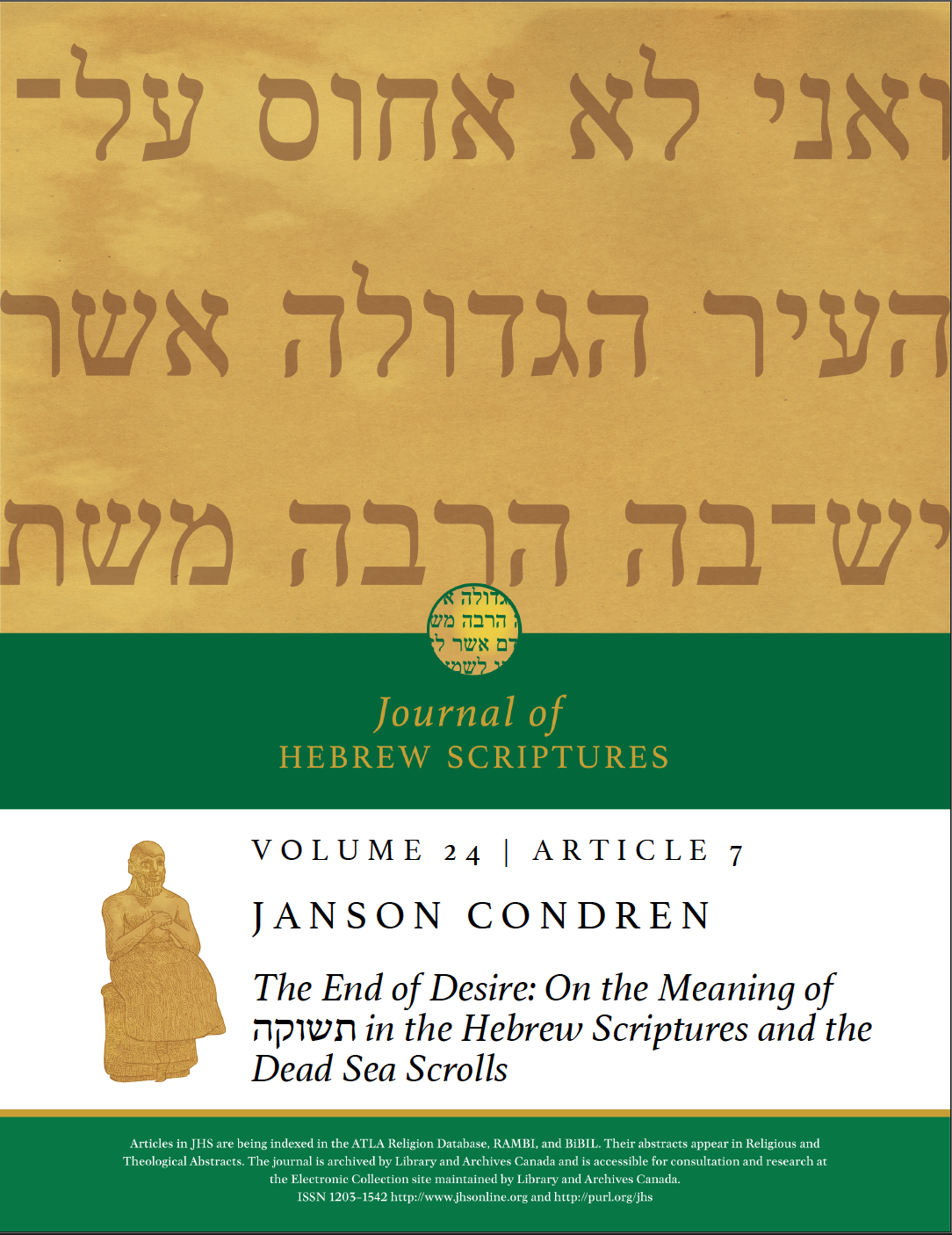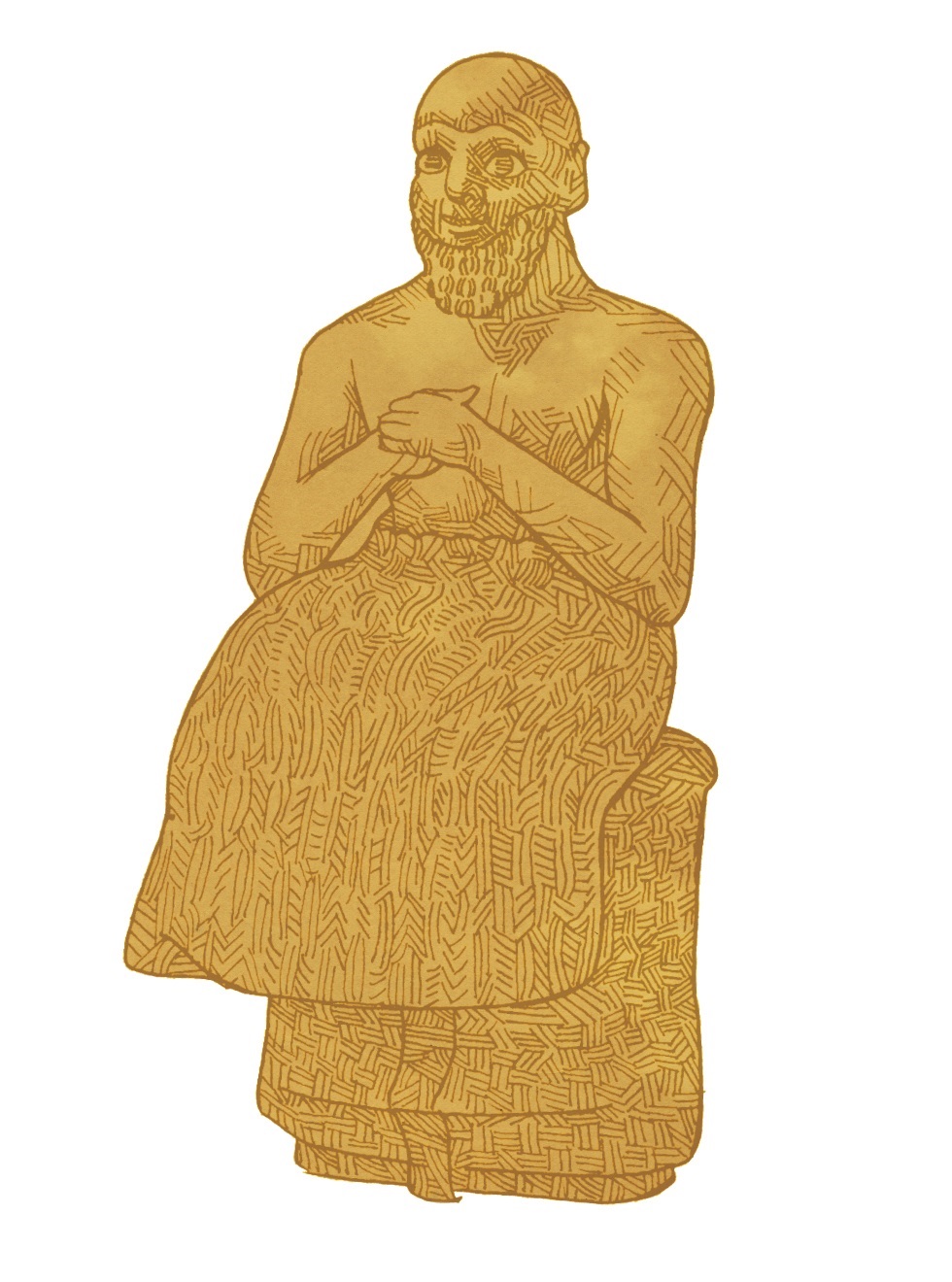The End of Desire: On the Meaning of תשׁוקה in the Hebrew Scriptures and the Dead Sea Scrolls
DOI:
https://doi.org/10.5508/jhs29657Keywords:
Genesis, Dead Sea Scrolls, Qumran, Song of Songs, semanticsAbstract
Despite the long-standing tradition of translating תשׁוקה as “desire” in its three biblical occurrences (Gen 3:16; 4:7; Cant 7:11 [Eng. 10]), recent studies have put forth alternatives such as “turning, return,” “preoccupation, devotion” and “driving.” This essay examines these possibilities in light of the usage of תשׁוקה in the Dead Sea Scrolls (1QM 13:12; 15:10; 17:4; 1QS 11:22; 4QInstrb 2:4). The meaning “desire” is shown to be particularly problematic, not only as a result of its absence in the earliest biblical versions, but also due to the expression לעפר תשׁוקתו immediately after a depiction of mankind being created from dust (עפר) in 1QS 11. The standard translation, “for dust is [mankind’s] desire,” appears incongruous, and parallels in Hodayot reinforce the likelihood that a “return” to dust is in view. The meanings “preoccupation, devotion” and “driving” also lack plausibility in 1QS 11, and “turning, return” proves problematic in 1QM 13 and 15. It is suggested the semantic range of תשׁוקה includes both “a focused movement toward” and “a focused movement back toward.” As such, it denotes “preoccupation, devotion” in most of its occurrences, yet indicates “return” in 1QS 11, and possibly Gen 3:16.
References
Abegg Jr., Martin G., ed. Qumran non-Biblical Manuscripts. Version 4.6. OakTree Software: Altamonte Springs, FL, 2014.
Abegg Jr., Martin G. and Casey Towes. Ben Sira (Canonical Order). Version 3.4. OakTree Software: Altamonte Springs, FL, 2009.
Arberry, Arthur J. The Koran Interpreted: A Translation. 2 vols. London: Allen and Unwin, 1955.
Arnold, Bill T. Genesis. New Cambridge Bible Commentary. Cambridge: Cambridge University Press, 2009.
Berlin, Adele, and Marc Z. Brettler, eds. The Jewish Study Bible. Oxford: Oxford University Press, 2004.
Biblia Hebraica Stuttgartensia Quinta: Genesis. Edited by Adrian Schenker, et al. Stuttgart: Deutsche Bibelgesellschaft, 2017.
Botterweck, G. Johannes, Helmer Ringgren and Heinz-Josef Fabry, eds. Theological Dictionary of the Old Testament. Translated by John T. Willis et al. 15 vols. Grand Rapids: Eerdmans, 1977-2012.
Brown, Francis, S. R. Driver, and Charles A. Briggs. The Brown-Driver-Briggs Hebrew and English Lexicon. Peabody, MA: Hendrickson Publishers, 1979.
CAL (Comprehensive Aramaic Lexicon). Edited by Richard A. Taylor et al. Lexical data, 2004–2022. http://cal.huc.edu.
Charlesworth, James H. The Dead Sea Scrolls: Damascus Document, War Scroll, and Related Documents. Princeton Theological Seminary Dead Sea Scrolls Project. Vol 2. Tübingen: Mohr Siebeck, 1995.
Charlesworth, James H. The Old Testament Pseudepigrapha. 2 vols. Garden City, NY: Doubleday, 1985.
Clines, David J. A., ed. Dictionary of Classical Hebrew. 8 vols. Sheffield: Sheffield Academic, 1993-2011.
Condren, Janson C. "Toward a Purge of the Battle of the Sexes and 'Return' for the original meaning of Genesis 3:16b." Journal of the Evangelical Theological Society 60 (2017): 227-245.
Deurloo, Karl A. "תשׁוקה 'dependency,' Gen 4,7." Zeitschrift für die alttestamentliche Wissenschaft 99 (1987): 405-406.
Foh, Susan T. "What Is the Woman’s Desire?" Westminster Theological Journal 37 (1975): 376-383.
Frayer-Griggs, Daniel. “Spittle, Clay, and Creation in John 9:6 and Some Dead Sea Scrolls.” JBL 132 (2013): 659-670.
Fretheim, Terrence. "Genesis." In New Interpreter's Bible. Edited by Carol A. Newsom et al. Vol. 1. Nashville: Abingdon, 1994.
García Martínez, Florentino, and Eibert J. C. Tigchelaar. Dead Sea Scroll Study Edition. 2 vols. Leiden: Brill, 1997.
Gunkel, Hermann. Genesis. Translated by M. Biddle. Mercer Library of Biblical Studies. Macon, GA: Mercer University Press, 1997.
Hasselbalch, Trine Bjørnung. Meaning and Context in the Thanksgiving Hymns: Linguistic and Rhetorical Perspectives on a Collection of Prayers from Qumran. Atlanta: Society of Biblical Literature, 2015.
Hayward, C. T. R. Jerome’s Hebrew Questions on Genesis. OECS. Oxford: Clarendon, 1995.
Hempel, Charlotte. The Community Rules from Qumran: A Commentary. TSAJ 183. Tübingen: Mohr Siebeck, 2020.
Holm-Nielsen, Syend. Hodayot: Psalms from Qumran. ATDan 2. Aarhus, Denmark: Universitetsforlaget, 1960.
Hopkins, Simon. "Hebrew tǝšuqā and Arabic šawq 'desire' — an etymological study." Wiener Zeitschrift für die Kunde des Morgenlandes 101 (2011): 213-231.
Hughes, Julie A. Scriptural Allusions and Exegesis in the Hodayot. STDJ 59. Leiden: Brill, 2006.
Koehler, Ludwig, and Walter Baumgartner. The Hebrew and Aramaic Lexicon of the Old Testament. Revised by Walter Baumgartner and Johann Jakob Stamm. Translated by M. E. J. Richardson. 5 vols. Leiden: Brill, 1994-2000.
Kister, Menahem. "Metamorphoses of Aggadic Traditions." Tarbiz 60 (1991): 179-224.
Kuhn, Heinz-Wolfgang. Enderwartung und gegenwärtiges Heil: Untersuchungen zu den Gemeindeliedern von Qumran mit einem Anhang über Eschatologie und Gegenwart in der Verkündigung Jesu. Göttingen: Vandenhoeck & Ruprecht, 1966.
Lohr, Joel M. "Sexual Desire? Eve, Gen 3:16 and תשׁוקה." Journal of Biblical Literature 130 (2011): 227-246.
Macintosh, A.A. "The Meaning of Hebrew תשׁוקה." Journal of Semitic Studies 61 (2016): 365-387.
Metso, Sarianna. The Community Rule: A Critical Edition with Translation. EJL 51. Atlanta: SBL, 2019.
Meyer, Nicholas A. Adam's Dust and Adam's Glory in the Hodayot and the Letters of Paul: Rethinking Anthropogony and Theology. NovTSup 168. Leiden: Brill, 2016.
Meyers, Carol L. "Gender Roles and Genesis 3:16 Revisited." Pages 347-363 in The Word of the Lord Shall Go Forth: Essays in Honor of David Noel Freedman in Celebration of His Sixtieth Birthday. Edited by Carol L. Meyers and Michael O’Connor. Winona Lake, IN: Eisenbrauns, 1983.
Muraoka, T. A Greek-English Lexicon of the Septuagint. Louvain: Peters, 2009.
Newsom, Carol A. "Deriving Negative Anthropology." CBR 10 (2011): 258-274.
Newsom, Carol A. The Self As Symbolic Space: Constructing Identity and Community at Qumran. STDJ 52. Leiden: Brill, 2004.
Parker, Benjamin H. and Martin G. Abegg Jr. Ben Sira English Translation. Version 1.3. OakTree Software: Altamonte Springs, FL, 2008.
Parry, Donald W., and Emanuel Tov. Texts Concerned with Religious Law. DSSR 1. Leiden: Brill, 2004.
Philo. Questions and Answers on Genesis. Translated by Ralph Marcus. 2 vols. LCL. London: William Heinemann, 1953.
Provan, Iain. Discovering Genesis: Content, Interpretation, Reception. Grand Rapids: Eerdmans, 2016.
Qimron, Elisha. “Biblical Philology and the Dead Sea Scrolls” (Hebrew). Tarbiz 58 (1989): 297-315.
Rabin, Chaim. "Etymological Notes" (Hebrew). Tarbiz 33 (1963): 114-117.
Rashi. http://www.sefaria.org/Rashi_on_Genesis.3.16?lang=en.
Reuling, Hanneke. After Eden: Church Fathers and Rabbis on Genesis 3:16–21. Jewish and Christian Perspectives Series 10. Leiden: Brill, 2006.
Schuller, Eileen. "Recent Scholarship on the Hodayot." CBR 10 (2011): 119–62.
Skinner, John. A Critical and Exegetical Commentary on Genesis. 2nd ed. ICC. Edinburgh: T&T Clark, 1930.
Vermes, Geza. The Complete Dead Sea Scrolls in English. New York: Penguin, 1997.
Von Rad, Gerhard. Genesis: A Commentary. Translated by J. Marks. Revised ed. Old Testament Library. Philadelphia: Westminster, 1972.
Waltke, Bruce K., and M. O'Connor. An Introduction to Biblical Hebrew Syntax. Winona Lake, IN: Eisenbrauns, 1990.
Wenham, Gordon J. "Genesis." Pages 41-90 in Eerdmans Commentary on the Bible. Edited by James D. G. Dunn and John W. Rogerson. Grand Rapids: Eerdmans, 2003.
Wenham, Gordon J. Genesis 1–15. Word Biblical Commentary. Nashville: Thomas Nelson, 1987.
Wise, Michael, Martin Abegg, Jr. and Edward Cook. The Dead Sea Scrolls: A New Translation. Revised Ed. London: HarperCollins, 2005.

Downloads
Published
How to Cite
Issue
Section
License
Copyright (c) 2025 Janson Condren

This work is licensed under a Creative Commons Attribution 4.0 International License.

 Statue of Ebih-Il, drawing by Simeon Goa, © Journal of Hebrew Scriptures
Statue of Ebih-Il, drawing by Simeon Goa, © Journal of Hebrew Scriptures
